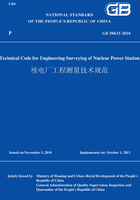
4.4 GPS Elevation Survey
4.4.1 GPS elevation survey shall be only applicable to elevation surveys of fifth order in plain or hilly areas.
4.4.2 GPS elevation surveys should be accompanied by GPS horizontal control surveys.GPS observation shall meet the relevant technical requirements for Class I GPS given in 3.2.
4.4.3 The main technical requirements for GPS elevation surveys are as follows:
1 GPS elevation control network shall be connected with the benchmarks of forth or higher order in survey area.The GPS points requiring connection with benchmarks should be arranged in the periphery and the center of survey area.For strip terrains,such GPS points shall be arranged at the strip ends and the center.
2 At least three GPS points shall be connected with benchmarks.
3 In areas with rugged terrain,such connecting points shall be added accordingly.
4.4.4 GPS elevation fitting computation shall comply with the following requirements:
1 The connected benchmarks shall be tested for reliability,and any unreliable points shall be eliminated.
2 For small,flat survey areas,planar fitting model can be used;for large,rugged survey areas,curve fitting model should be used.
3 The elevation calculation of GPS points should not exceed the coverage of elevation fitting models.
4 The elevation fitting models shall be optimized before use.
5 Full use of the local gravity geoid model or data shall be made.
4.4.5 At least 10% of all GPS points or three GPS points,whichever is greater,shall undergo tests of their fitted elevations.Ordinary leveling or EDM-trigonometric leveling technique of the equivalent order can be used for testing elevation differences.The discrepancy between elevation differences shall not exceed ![]() (D is the length of route being tested,km).
(D is the length of route being tested,km).
4.4.6 In office work,GPS antenna height and all calculations shall be rounded to 1mm.